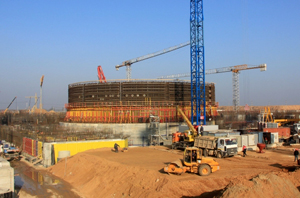Ru
|
Eng
No radiation impact on environment from BelNPP construction
19.05.2015

The construction of the Belarusian nuclear power plant (BelNPP) has no radiation impact on the environment, Olga Zhukova, Candidate of Science (Engineering), Head of the Radiation and Ecological Monitoring Research Department of the National Center for Hydrometeorology, Radioactive Pollution Control, and Environmental Monitoring of Belarus, said during an online conference hosted by BelTA on 19 May.
“The construction of the BelNPP has no radiation impact on the environment in the area. No problems in the environment have been detected,” she stressed.
In her words, the radiation environment at the construction site of the BelNPP is mainly determined by the presence of natural radionuclides and low leftover radioactive contamination from nuclear weapons tests in the 1950-60s. “Thus we can state that the radiation situation near the construction site of the BelNPP is stable, which is attested by the results of the radiation survey carried out between 2009 and 2014,” Olga Zhukova pointed out.
The volumetric activity of caesium-137 and strontium-90 in surface waters and the specific activity of caesium-137 and strontium-90 in sediments do not exceed background levels. The density of soil contamination with caesium-137 ranges from 0.02 to 0.04 Ci/km2, with strontium-90 from 0.02 to 0.03 Ci/km2.
The Belarusian nuclear power plant is a project to build an AES-2006 type nuclear power plant 18km away from Ostrovets, Grodno Oblast. The Belarusian nuclear power plant will have two power-generating units with the total output capacity of up to 2,400MW (2x1,200MW). The Russian merged company OAO NIAEP – ZAO ASE is the general designer and the general contractor of the project. In line with the general contract for building the nuclear power plant the first power-generating unit is scheduled for commissioning in 2018, with the second one to go online in 2020.
“The construction of the BelNPP has no radiation impact on the environment in the area. No problems in the environment have been detected,” she stressed.
In her words, the radiation environment at the construction site of the BelNPP is mainly determined by the presence of natural radionuclides and low leftover radioactive contamination from nuclear weapons tests in the 1950-60s. “Thus we can state that the radiation situation near the construction site of the BelNPP is stable, which is attested by the results of the radiation survey carried out between 2009 and 2014,” Olga Zhukova pointed out.
The volumetric activity of caesium-137 and strontium-90 in surface waters and the specific activity of caesium-137 and strontium-90 in sediments do not exceed background levels. The density of soil contamination with caesium-137 ranges from 0.02 to 0.04 Ci/km2, with strontium-90 from 0.02 to 0.03 Ci/km2.
The Belarusian nuclear power plant is a project to build an AES-2006 type nuclear power plant 18km away from Ostrovets, Grodno Oblast. The Belarusian nuclear power plant will have two power-generating units with the total output capacity of up to 2,400MW (2x1,200MW). The Russian merged company OAO NIAEP – ZAO ASE is the general designer and the general contractor of the project. In line with the general contract for building the nuclear power plant the first power-generating unit is scheduled for commissioning in 2018, with the second one to go online in 2020.
BELNPP: NEWS FROM CONSTRUCTION SITE
23.07.2024
11.07.2024
28.06.2024
06.06.2024
04.06.2024
04.06.2024
03.06.2024
24.05.2024
23.05.2024
03.05.2024













